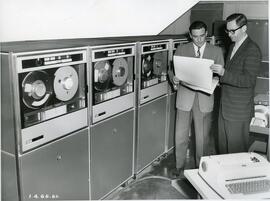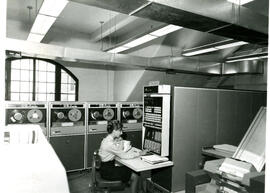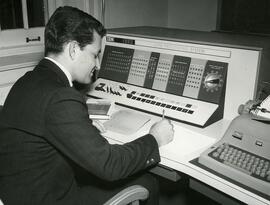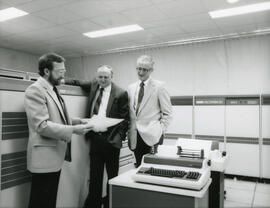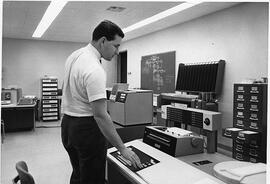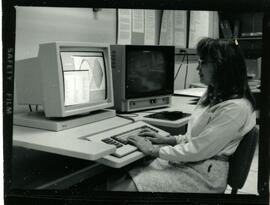Department of Computation of Science
- A-138
- Item
- 1966
Standing beside a group of six computers from International Business Machines (IBM) are two unidentified [representatives], reading from a printout. Typewriter/keyboard in foreground.
Bio/Historical Note: A brief history of the early years of the Department of Computer Science until 1980: The University of Saskatchewan entered the computer age in 1959 with the installation of a Librascope General Precision LGP-30 computer. It was in the Mathematics department, located in the basement of the Crop Science Building, as it was too large to fit in the elevator in the Arts Building. The machine was designed to fit into a Steelcase office desk, and had 4096 words of 31-bit magnetic drum memory. It was jointly owned by the Saskatchewan Research Council, the National Research Council Prairie Regional Laboratory, and the University. In 1963 an IBM 1620 machine was installed on the third floor of the Engineering Building. It was a punch-card oriented machine operated by its users (one at a time). Some programming courses were given in Engineering, Commerce and Mathematics, but there was no full-time support organization for computing until 1965, when an IBM 7040 ‘mainframe’ was purchased with funding assistance from the National Research Council (NRC). The NRC at that time had a one-time program to ‘kick-start’ computing capacity and usage at Canadian universities, and for the U of S, this resulted in the acquisition of the IBM 7040, a significant step up from the model 1620. Along with the facility, the Department of Computing Services was created under its first manager, Glenn W. Peardon (1928-2018). The 7040 was installed in July 1965, also in the Engineering building. The 1620 was retired in October of that year. Only a little over a year later the demands for computing were exceeding the capacity of the 7040, and an IBM 1401 was added to handle more work. In June 1967 it was proposed that a new machine be obtained, an IBM 360 Model 50. This was a mid-sized mainframe of that era and was expected to provide sufficient capacity until October 1968. It was installed in a new location in December 1967 in Room 70 Arts Building, and although it was expected to be in service for only one year, it was still in place by July 1970.
Under the headship of Dr. Blaine Holmlund (1930-2006), the Department of Computational Science was established in 1967, and first offered classes in 1968. The computer support staff consisted of 22 operators, programmers and analysts. It was initially created as a department of the whole university, i.e., it did not belong to a particular college, as it was felt that it would have strong programs in all of Engineering, Arts and Science and Commerce. It did not join up with a college until many years later. The July 1970 purchase of the Hewlett Packard 2000A time-sharing system, which was a minicomputer capable of handling up to 16 simultaneous users (later expanded to 32). In October 1971 the Computer Advisory Committee in Saskatoon received a recommendation from the Universities Study Group (that had responsibility to the University as a whole), that the campus needs could best be handled by acquiring both an IBM 370/155 and a DECsystem 10. In 1973 the university installed a DECsystem 2050, its first time-sharing system. It served up to 32 simultaneous users, and was programmed in BASIC. In 1974 the department was renamed the Department of Academic and Computing Services. The DECsystem 2050 was installed in early 1979 and was upgraded to a 2060 in 1980. This system was called DEUS, for Data Entry, University of Saskatchewan; it consisted of a DEC PDP-11/70 minicomputer and 44 CRT stations in room 145 Arts. Following its installation, there was a rapid growth in its use, as the needs first expressed in 1970 were finally met with some adequate functionality in 1979. The DECsystem 2050 was upgraded to a 2060 in 1980.

